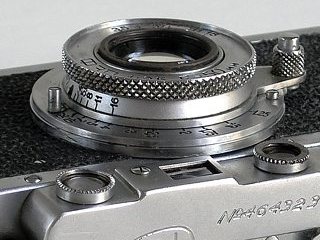
|
Fed — a Soviet Leica clone |

| Back to Vintage Cameras |

|
The camera was usually sold with the standard FED 50mm/3.5 lens, very similar to the Soviet Industar one. Generally it was not bad, although the quality could vary quite widely. The lens collapses almost flush with the body, and the focusing lever would lock itself in the infinity position, requiring a press of a button to move it from there. There is a depth-of-field scale provided. A number of other lenses for this camera has been made, ranging from 28 mm to 105 mm, but these are not easy to find. |
|
Camera specs at a glance Not much to elaborate upon: just what is needed to take a picture.
Later FEDs and other Soviet Leica clones In the late Forties, with the not-yet-rebuilt FED factory being unable to satisfy the demand (or rather, in Soviet terms, to meet the quota), some FEDs started to be assembled in the Krasnogorsk Optical Factory in Russia. After a year or so, those cameras got a separate brand name: Zorki, still being an exact clone of the FED. In mid-Fifties both factories released newer, improved models, and the lines diverged, both from each other, and from the original Leica. FED-2 (1955) had, notably, a wider-base rangefinder combined with a viewfinder, and a detachable back, which makes the camera usable even today. FED-3 added slower shutter speeds. The later models went the mass-market way and are not really interesting. Web resources Here are some resources I was able to find. Remember, however, that Web articles come and go, so I cannot guarantee that these are still alive when you are reading this.
Unfortunately, an enjoyable and informative, article by Stephen Rosenbach, Rangefinder Cameras of the Soviet Era, accompanied with serious photography done with those vintage cameras, seems no longer available at the original URL. | |

| Back to Vintage Cameras |
| Home: wrotniak.net | Search this site | Change font size |
| Posted 2003/12/07; last updated 2018/09/12 | Copyright © 2003-2018 by J.Andrzej Wrotniak. |